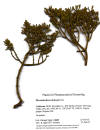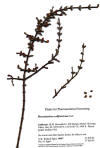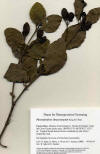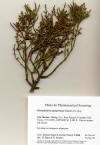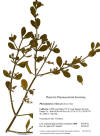Phoradendron bolleanum
|
Phoradendron bolleanum |
Phoradendron californicum |
|
Phoradendron bolleanum CA. Kern Co., California: Northern slopes of Piute Mt., white fir-Jeffrey pine forest, elev. >6,000 ft. CNPS Chapter field trip June 1, 2013. |
||
|
Phoradendron
californicum |
Phoradendron
chrysocarpum |
Phoradendron juniperinum |
|
Phoradendron leucarpum
|
Phoradendron leucarpum |
Phoradendron
leucarpum
|
|
Trees and Shrubs of Kern County (Feb 2013 Dec 2013) Phoradendron Parasitic on the branches of shrubs or trees; branches brittle, green (photosynthetic), dichotomous, swollen or constricted at nodes; leaves scale-like or blade-like, opposite; flowers in grape-like clusters on floriferous branches, or immersed in a jointed rachis, generally in threes (cymes), unisexual on same or different plants, 34 merous, greenish; calyx cupular, shallowly 3 lobed to toothed; petals united to form a corolla tube; gynoecium syncarpous, 34 carpelled, inferior, unilocular,1 style. Fruit: Berry, red, pink, or white. >200 species, New World; 4 spp. & 2 varieties in California (JM2), 3 spp. and 2 varieties in Kern County; 7 species used medicinally by native North American Indians (Moerman), 2 active in the NCI antitumor screen prior 1980, P. bolleanum (P-388 Leukemia) from California, P. serotinum (P-399, KB) from Texas, Alabama, and Oklahoma. Key to species of Phoradendron in Kern County
1. Plants appearing
leafless, the leaves small triangular scales, < 1 mm, the
2. Leaf pairs distant, not overlapping; fruits red; on Acacia,
Parkinsonia,
2. Leaves overlapping like juniper leaves; fruit whitish pink
like pearls; 1 . Plants with spreading distinct blade-like leaves, 560 mm......................................... 3
3. Leaves thick, club-shaped to paddle-shaped, > 3 Χ longer
3. Leaves flattened and wider, spoon-shaped, < 1.5 Χ longer than
wide,
...... 4. Leaves yellowish green.......
....................................... ssp. macrophyllum
Phoradendron bolleanum (Viscum bolleanum Seeman 1856) Eichler 1868 [Includes P. densum Torrey ex Trelease 1916, distinguish in Moe (P. bolleanum var. densum Fosberg 1941) by leaves 1015 mm and occurring on juniper, recognized in Twisselmann as common on California juniper; P. pauciflorum Torrey 1857, distinguished in Moe (P. bolleanum var. pauciflorum Fosberg 1941) by leaves 1530 mm long and occurring on white fir, reported in Twisselmann as scarce on white fir]. Juniper mistletoe. On conifers of cypress, juniper, and white fir, 7002,500 m; Klamath Ranges, North Coast Ranges, Cascade Range, Sierra Nevada, Transverse Ranges, Peninsular Ranges, Great Basin Desert; to southern Oregon, southern Arizona, northwestern Mexico. Type from Durango, Sierra Madre, Mexico. Kern Co.: Common on California juniper. Southern Sierra Nevada: Near Tiger Flat, east side of Sunday Peak, Greenhorn Mountains; Owens Peak Eastern Watershed, along the Pacific Crest Trail, on the northeast side of Mount Jenkins; San Emigdio Canyon, (CCH). Phoradendron californicum Nuttall 1848. Mesquite mistoletoe. Occurring primarily on Acacia, Olneya, Parkinsonia and Prosopis, Death Valley region and Sonoran Desert, <1,200 m. Kern Co.: CalFlora with a single reference to Moe and to a literary report indicating an occurrence in Kern County; no specimens cited, none in CCH. One specimen from Los Angeles Co reportedly collected in the Transverse Ranges, Liebre Mountains region, Mint Canyon (L. E. Hoffman, 25 Feb 1933; CCH). Berries used by native American Indians as purge or for stomachaches, or the whole plant taken as infusion to wash sores (Moerman). Phoradendron juniperinum Engelmann 1849. Incense cedar mistletoe. JulSep. Pinyon/juniper woodland, ponderosa-pine forest, on incense cedar and juniper, 17002600 m. Klamath Ranges, North Coast Ranges, High Cascade Range, northern Sierra Nevada Foothills, High Sierra Nevada, Inner South Coast Ranges, Transverse Ranges, Peninsular Ranges, Great Basin Floristic Province, Mojave Desert; to Oregon, Colorado, Texas, Mexico. Type from Chihuahua, Mexico. Includes Phoradendron juniperinum Engelmann var. libocedri Englemann 1880 (Phoradendron libocedri (Engelmann) Howell 1902). Kern Co.: Southern Sierra Nevada, Greenhorn Mountains, Kern River Drainage Area, Tiger Flat (CCH, scarce on incense cedar (Twisselmann). Plant used by native American Indians for stomach, treating diarrhea, in Witchcraft Medicine,. rheumatism, to relieve stress, emetic, child birth to relax muscles and reduce blood flow (Moerman). Phoradendron leucarpum (Viscum leucarpum Rafinisque 1817) Reveal & M.C. Johnston 1989 subsp. macrophyllum (Engelmann 1879) J.R. Abbott & R.L. Thompson 2011. [Phoradendron (Viscum serotinum Rafinisque 1820) M.C. Johnston 1957 subsp. macrophyllum (Phoradendron flavens Grisebach 1860 var. macrophyllum Engelmann 1879) Kuijt 2003]. American Mistletoe. On trees other than Quercus (especially Alnus, Fraxinus, Juglans, Platanus, Populus, Robinia, Salix); < 1200 m. Outer North Coast Ranges, Inner North Coast Ranges, Sierra Nevada Foothills, Great Central Valley, Central Western California, South Coast, Transverse Ranges, Peninsular Ranges, Desert; to Colorado, w Texas, Baja California. DecMar. Kern Co.: Occasional, sometimes locally common and dense, on Populus fremontii, Platanus spp., Robinia pseudo-acacia near the alkali flats at Kernville (Twisselmann). Also, recorded from southeast of Shafter, Cottage Grove Cemetery, San Emigdio Ranch in Salt Creek Canyon at confluence with Black Bob Canyon and up Bl. Bob Canyon in association with Quercus douglasii, Juniperus californica, Ribes quercetorum, Populus fremontii; 5 miles from Caliente, Caliente Creek; Weldon; Bakersfield; Rio Bravo (CCH). Plant used by American Indians for treating dandruff (Moerman), Phoradendron leucarpum subsp. tomentosum (Viscum tomentosum DeCandolle 1830) J. R. Abbott & R. L. Thompson 2011. [Phoradendron serotinum subsp. tomentosum (Viscum tomentosum DeCandolle 1830) Kuijt 2003; includes Phoradendron villosum (Viscum villosum Nuttall 1840) Engelmann 1850]. Hairy mistletoe. Flowers JulSep. Generally on Quercus, rarely on Adenostoma, Arctostaphylos, Rhus, Umbellularia; 602,100 m. Klamath Ranges, North Coast Ranges, Cascade Range, Sierra Nevada, Great Central Valley, San Francisco Bay Area, South Coast Ranges, South Coast, Transverse Ranges, Peninsular Ranges, Mojave Desert; to n Oregon, Texas, Mexico. Kern Co.: Common on oaks (Twisselmann); Dons Canyon, flank of Cedar Canyon (Twisselmann, 5 Oct 1965); west end of Cuddy Valley on road to Mt. Pinos summit, north side of road, 1692 m (C. Davidson & J. A. Churchill, 16 Sep 1976); Sierra Nevada: east arm of Walker Basin near Cholly Canyon, 1127 m (J. T. Howell, 26 Sep 1970); Sierra Nevada: Lightners Flat on road from Mt Breckenridge to Havilah, 1828 m (G. H. True & J. T. Howell, 15 Jun 1971); Kern River Canyon, on Quercus wislizenii, Spjut photo (3 Apr 2012).
Harmsma M, M. Ummelen,W. Dignef, K. J. Tusenius and F. C. Ramaekers. 2006. Effects of mistletoe (Viscum album L.) extracts Iscador on cell cycle and survival of tumor cells. Arzneimittelforschung. 56(6A): 474482. The molecular and cellular mechanisms by which mistletoe (Viscum album L.) extracts exert cytotoxic and immunomodulatory anti-tumoral effects are largely unknown. In this study the hypothesis that Iscador preparations induce tumor regression by cell cycle inhibition and/or interference with apoptotic signaling pathways in cancer cells was investigated. Also a possible effect on angiogenesis, which is a prerequisite for tumor growth in vivo, is studied in endothelial cell cultures. Furthermore, it was examined which apoptotic signaling route(s) is (are) activated by Iscador by studying specific pro-apoptotic proteins in cultured cells. To characterize these properties, 9 human cancer cell lines of different origin, one epidermis derived cell line and 2 endothelial cell cultures were incubated with different concentrations of Iscador Quercus Spezial and Iscador Malus Spezial. Cell cycle kinetic parameters were measured by bromodeoxyuridine (BrdU) pulse labeling and tubulin staining. Apoptotic responses were detected by M30 Cyto-Death or Annexin V/propidium iodide assays. Characterization of the apoptotic pathway(s) was performed by staining cells for amongst others active caspase 3 and cytochrome C (mitochondrial pathway), as well as active caspase 8 (death receptor pathway). The sensitivity to Iscador treatment varies strongly between different cell lines and also ing those derived from small cell lung cancer, and adenocarcinoma of the lung and breast, as well as endothelial cell cultures, Iscador caused early cell cycle inhibition followed by apoptosis in a dose dependent manner. Amongst the low responders are cell lines derived from colorectal carcinoma. In general Iscador Malus exerted a stronger response than Iscador Quercus. Apoptosis was induced by activating the mitochondrial but not the death receptor dependent pathway, at least in case of Iscador Quercus. Iscador Malus also seemed to induce apoptosis via the death receptor route, which may explain the higher sensitivity of cancer and endothelial cells to this preparation. Johansson, D. J. Gullbo, P. Lindholm, B. Ek, E. Thunberg, G. Samuelsson, R. Larsson, L. Bohlin and P. Claeson. Small, novel proteins from the mistletoe Phoradendron tomentosum exhibit highly selective cytotoxicity to human breast cancer cells "Four novel proteins (phoratoxins CF) have been isolated from the North American mistletoe Phoradendron tomentosum. The amino acid sequences of these phoratoxins were determined unambiguously using a combination of Edman degradation and trypsin enzymatic digestion, and by electrospray ionization tandem mass spectrometry sequencing. Phoratoxins C, E and F consist of 46 amino acid residues; and phoratoxin D of 41. All proteins had six cysteines, similar to the earlier described phoratoxins A and B, which are thionins. The cytotoxicity of each protein was evaluated in a human cell line panel that represented several cytotoxic drug-resistance mechanisms. For the half-maximal inhibitory concentrations (IC50 values) of the different cell lines in the panel, correlation with those of standard drugs was low. The most potent cytotoxic phoratoxin C was further tested on primary cultures of human tumor cells from patients. The solid tumor samples from breast cancer cells were 18 times more sensitive to phoratoxin C than the tested hematological tumor samples. " Kim Y. K., Y. S. Kim, S. U. Choi and S. Y. Ryu. 2004. Isolation of flavonol rhamnosides from Loranthus tanakae and cytotoxic effect of them on human tumor cell lines. Arch. Pharm. Res. 27(1): 4447. Loranthus tanakae Fr. et Sav. (Loranthaceae) is a species of mistletoe, a semiparasitic plant growing on the branches of Quercus and Betula species as host trees. In our ongoing search for bioactive compounds from endemic species in Korea, we have investigated to isolate the chemical constituents responsible for the antitumor effect of the MeOH extract of L. tanakae. The ethylacetate soluble part of the MeOH extract demonstrated a marginal inhibition on the proliferation of the tumor cell lines such as A549 (non small cell lung), SK-OV-3 (ovary), SK-MEL-2 (melanoma), XF498 (central nerve system), and HCT-15 (colon) in vitro. Thus, the activity-guided isolation procedure upon the ethylacetate soluble part of the extract has been carried out and finally four flavonoid rhamnopyranosides (1-4) were isolated as active principle. The structures of 1-4 were elucidated by the physicochemical and spectral data as rhamnetin 3-O-alpha-L-rhamnoside (1), quercetin 3-O-alpha-L-rhamnoside (2), rhamnocitrin 3-O-alpha-L-rhamnoside (3), and kaempferol 3-O-alpha-L-rhamnoside (4).
|
||

